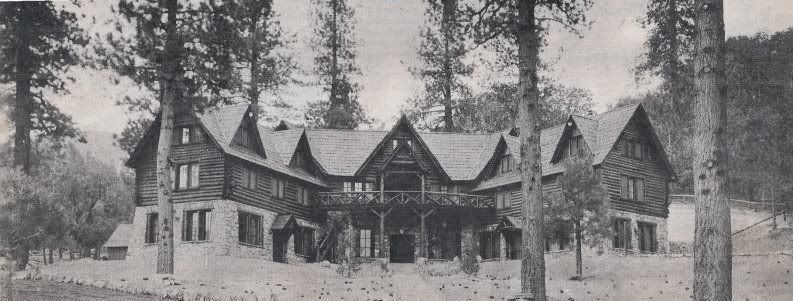
BUILT LIKE A MACK
Just a short time after the opening ceremony of Acorn Lodge, another marvelous mountain home was being built by Wrightwood general contractor George Scribner. Just seventy yards to the west of Acorn Lodge, at the junction of present day Mocking Bird and Acorn, the biggest house this side of the San Gabriel mountains was taking shape among the towering pines. However, its life would be short. From the moment that the last glowing embers cooled and till the 1970's where its foundation and fireplace ruins greeted curious onlookers with awe, the Stoner Lodge, better known as "The Gables", always had an air of mystery to it.
The Stoner Lodge's existence was contributed to an incident that occurred on the other side of the mountain on Mount Wilson thirteen years earlier. Mount Wilson Solar Observatory was founded in 1904 by George Ellery Hale and the word "Solar" was dropped from the name in 1919 after the completion of the observatory's 100-inch telescope. It was this 100- inch telescope and Wrightwood's Stoner Lodge that gave both sides of the mountain range an interesting connection.
Building the Mount Wilson Observatory was an unbelievable chore. Forest Ranger Harvey R. Chessman noted that the busiest place in the mountains was Mount Wilson, where a great number of men fashioned the crude surface road up the mountain's summit and hauled materials over the rough land. The location of the new observatory was on the 5700 foot Wilson Mountain and at the end of a steep and boulder-filled nine mile footpath. The only way to get there was by foot or on the back of a horse or mule. In short time, the Wilson Toll Road was put in and by 1915, daily trips to bring materials to the new Wilson Solar Observatory were being made. By 1917 the road was twelve feet wide as it cut through the precarious mountainside and it still took great skill to navigate it. The first solar telescope had been transported by mule trains in a task that took sixty trips! A few years later a 60-inch telescope was hauled by both mules and a primitive truck. (Mules were rested every other day and the pack train didn't operate during the winter months). According to Mount Wilson Observatory history, no matter how man got used to the tedious trek over the rough mountain road, accidents still happened. "A brand new Mack truck went over the edge near a place called Buzzard's Roost, carrying its driver down 300 feet into a steep canyon. Walter Adams and the assistant driver jumped before the truck took the plunge. The three escaped injury, but the truck was a total loss."